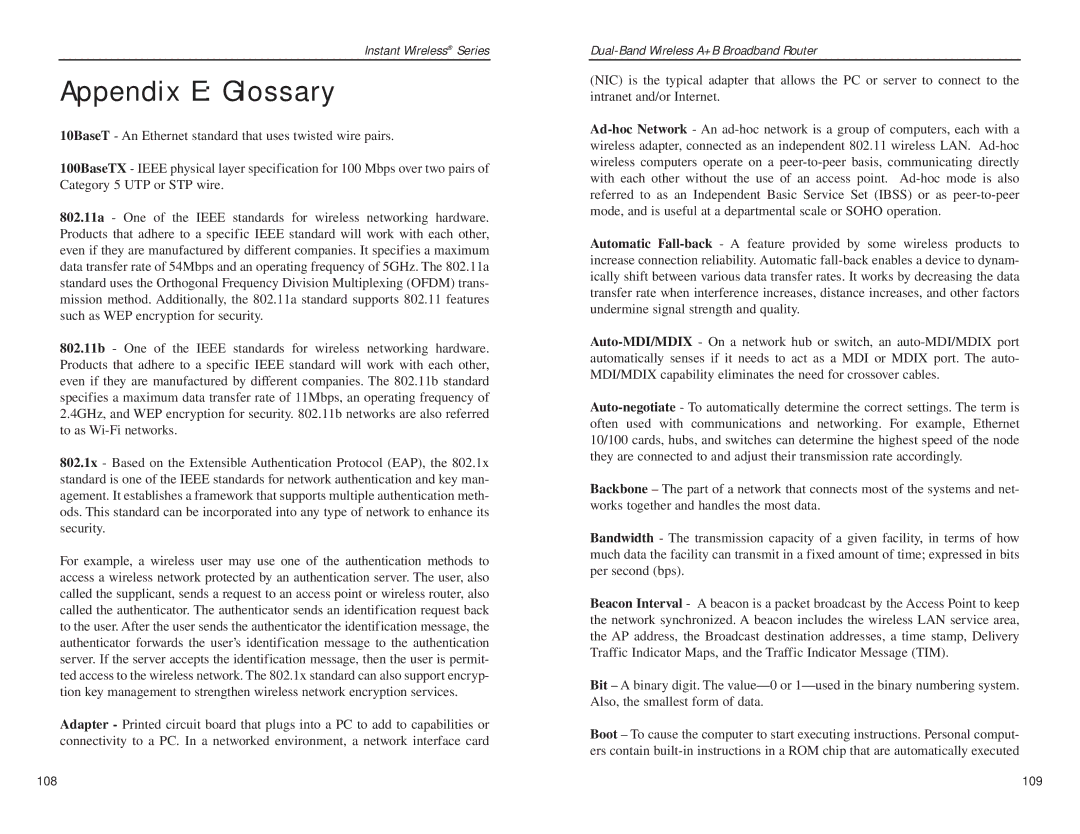Instant Wireless® Series
Appendix E: Glossary
10BaseT - An Ethernet standard that uses twisted wire pairs.
100BaseTX - IEEE physical layer specification for 100 Mbps over two pairs of Category 5 UTP or STP wire.
802.11a - One of the IEEE standards for wireless networking hardware. Products that adhere to a specific IEEE standard will work with each other, even if they are manufactured by different companies. It specifies a maximum data transfer rate of 54Mbps and an operating frequency of 5GHz. The 802.11a standard uses the Orthogonal Frequency Division Multiplexing (OFDM) trans- mission method. Additionally, the 802.11a standard supports 802.11 features such as WEP encryption for security.
802.11b - One of the IEEE standards for wireless networking hardware. Products that adhere to a specific IEEE standard will work with each other, even if they are manufactured by different companies. The 802.11b standard specifies a maximum data transfer rate of 11Mbps, an operating frequency of 2.4GHz, and WEP encryption for security. 802.11b networks are also referred to as
802.1x - Based on the Extensible Authentication Protocol (EAP), the 802.1x standard is one of the IEEE standards for network authentication and key man- agement. It establishes a framework that supports multiple authentication meth- ods. This standard can be incorporated into any type of network to enhance its security.
For example, a wireless user may use one of the authentication methods to access a wireless network protected by an authentication server. The user, also called the supplicant, sends a request to an access point or wireless router, also called the authenticator. The authenticator sends an identification request back to the user. After the user sends the authenticator the identification message, the authenticator forwards the user’s identification message to the authentication server. If the server accepts the identification message, then the user is permit- ted access to the wireless network. The 802.1x standard can also support encryp- tion key management to strengthen wireless network encryption services.
Adapter - Printed circuit board that plugs into a PC to add to capabilities or connectivity to a PC. In a networked environment, a network interface card
(NIC) is the typical adapter that allows the PC or server to connect to the intranet and/or Internet.
Automatic
Backbone – The part of a network that connects most of the systems and net- works together and handles the most data.
Bandwidth - The transmission capacity of a given facility, in terms of how much data the facility can transmit in a fixed amount of time; expressed in bits per second (bps).
Beacon Interval - A beacon is a packet broadcast by the Access Point to keep the network synchronized. A beacon includes the wireless LAN service area, the AP address, the Broadcast destination addresses, a time stamp, Delivery Traffic Indicator Maps, and the Traffic Indicator Message (TIM).
Bit – A binary digit. The
Boot – To cause the computer to start executing instructions. Personal comput- ers contain
108 | 109 |
